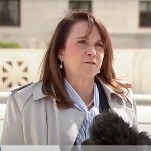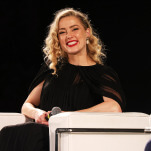'Manic Pixie Dream Girl' Has Lost All Meaning
LatestSometimes we come up with an idea that says something True. And we all get excited about it. Because, duh, True Thing Alert. But then sometimes we take our true thing and parade it around, and we start trying to make it a Universally True Thing of All Time, when really it was just a Sorta True Thing of a Moment, thereby taking it so ridiculously far that it threatens to lose all meaning, to collapse in on itself, to fog up the very true thing it was so good at clarifying. That has officially happened with the term Manic Pixie Dream Girl, which now apparently represents every female character ever written by a man since the dawn of time who was whimsical, offbeat, “not like other girls,” ethereally sexy, bookish, different, unique, angular, fucked up, bipolar, flirty, you name it. So grab yourself a lollipop, an impish grin and slap on an obscure jaunty record — we are all Manic Pixie Dream Girls now, ladiez.
The Manic Pixie Dream Girl thing started in True Year 2007, when AV Club writer Nathan Rabin noticed a real thing: a type of female character written by a dude who is basically a batshit/whimsical fairy lady on a mission to zip into your headspace and give you a boner for life. Along the way she imparts something of value to your understanding of the universe, like, maybe that it’s better to marry someone who remembers at least some of her appointments.
More specifically:
No existential quandary is so great that it can’t be solved by the perfect combination of pop song and dream girl, a world of giddy pop epiphanies and gentle humanism unencumbered by protective irony or sneering cynicism. […] Dunst embodies a character type I like to call The Manic Pixie Dream Girl (see Natalie Portman in Garden State for another prime example). The Manic Pixie Dream Girl exists solely in the fevered imaginations of sensitive writer-directors to teach broodingly soulful young men to embrace life and its infinite mysteries and adventures. The Manic Pixie Dream Girl is an all-or-nothing-proposition. Audiences either want to marry her instantly (despite The Manic Pixie Dream Girl being, you know, a fictional character) or they want to commit grievous bodily harm against them and their immediate family.
In a really thoughtful Girls on Film piece over at The Week, Monika Bartyzel takes this notion of “idiosyncratic muses” who basically exist to help a dude figure out his own boredom as a “once-useful piece of critical shorthand that has devolved into laziness and sexism.”
But wait! Remember when we first heard about Manic Pixie Dream Girls as a concept, and we were like YEAH! Exactly! That’s what they’re like! Because it is. And it was. It was such a satisfying term because it encapsulated exactly what was so annoying about those characters — that they were not super well-written or real enough, but some kind of figment of the imagination of a grown man in need of a pick-me-up of quirky youth injections into his limp excuse for a life. But the problem is that the term started getting applied to every kind of female character who was even remotely unique. Says Bartyzel:
But what, exactly, makes a character a Manic Pixie Dream Girl has always been a fluid construct. Rabin’s oft-quoted definition doesn’t actually describe the girl; it describes the audience’s experience of watching her. But with the references to Portman and Dunst’s roles in Garden State and Elizabethtown, a rough list of attributes could be inferred: The MPDG lives life “differently” than the average girl. She loves indie music, whimsy, and any number of idiosyncratic hobbies, from barefoot tap dancing to driving on “gloriously confusing” roads.
Bartyzel goes on to discuss the zeitgeistiness of the zeit — this astute call-out came on the heels of Kate Winslet’s brilliantly batty Eternal Sunshine character, just before Zooey Deschanel, master Manic Pixie Dream Girl of All Manic Pixie Dream Girls, delicately crashed onto the scene.
But then, like a criminal who must return to the scene of the crime, a year later we got an AV Club roundup of 16 MPDGs in movies, and it was usual suspects like Portman’s character in Garden State and Kirsten Dunst in Elizabethtown. Only now there were heavyweights like Audrey Hepburn in Breakfast at Tiffany’s, and Diane Keaton’s Annie Hall on the list. ZOMG.
If a fully fleshed-out character like Annie Hall, who leaves a dude and does her own thing, reclaiming her own confidence and identity along the way as she learns to ditch a relationship that holds back her own growth, counts as some half-baked male projection, then WTF for all of us? I’d happily trade my actual personality for her fake one! I know, Keaton’s character rambles a lot and has a kind of ditzy charm, but it ends up not being ditzy at all, and she ends up being a more together person than anyone else onscreen or probably even anyone standing around offscreen. How is that MPDG?
Bartzyel:
-

-

-

-

-

-

-

-

-

-

-

-

-

-

-

-

-

-

-

-

-

-

-

-

-

-

-

-

-

-

-

-

-

-

-

-

-

-

-

-








































